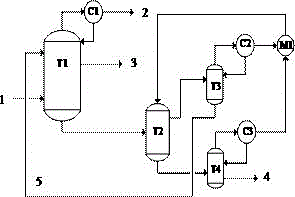Method for separating phenol, arene and alkane in direct coal liquefaction effluent through one-step method
A technology for directly liquefying oil and aromatics from coal, applied in the field of coal chemical industry, can solve the problems of high separation cost, low product purity, and low separation efficiency, and achieve the effects of broad application prospects, high product purity, and low system energy consumption
- Summary
- Abstract
- Description
- Claims
- Application Information
AI Technical Summary
Problems solved by technology
Method used
Image
Examples
Embodiment 1
[0030] In Example 1, the target products are phenolic compounds, aromatics and alkanes. Dimethyl sulfoxide is used as No. 1 solvent A for the narrow fraction to be separated at 150-180°C; sulfolane and dimethyl sulfone with a mass ratio of 1:1 are used as No. 2 solvent for the narrow fraction to be separated at 200-220°C a. The feeding method is continuous feeding.
[0031] The extractive distillation condition of 150-180 DEG C cut in the embodiment 1 of table 1
[0032] Process conditions
Extractive distillation column T1
Extraction tower T2
Number of plates
1
1
mass solvent ratio
1.0
-
Reflux ratio
0
-
Tower top temperature °C
190
25
Tower bottom temperature °C
225
25
Tower top pressure MPa
0.101
0.101
Tower bottom pressure MPa
0.121
0.111
[0033] The extractive distillation result of 150-180 DEG C cut in the embodiment 1 of table 2
[0034]
Embodiment 2
[0035] The extractive distillation condition of 200-220 ℃ in the embodiment 2 of table 3
[0036] Process conditions
Extractive distillation column T1
Extraction tower T2
Number of plates
3
1
mass solvent ratio
1.0
-
Reflux ratio
1
-
Tower top temperature °C
220
25
Tower bottom temperature °C
260
25
Tower top pressure MPa
0.101
0.101
Tower bottom pressure MPa
0.130
0.111
[0037] The extractive distillation result of 200-220 DEG C cut in the embodiment 2 of table 4
[0038]
PUM
 Login to View More
Login to View More Abstract
Description
Claims
Application Information
 Login to View More
Login to View More - R&D
- Intellectual Property
- Life Sciences
- Materials
- Tech Scout
- Unparalleled Data Quality
- Higher Quality Content
- 60% Fewer Hallucinations
Browse by: Latest US Patents, China's latest patents, Technical Efficacy Thesaurus, Application Domain, Technology Topic, Popular Technical Reports.
© 2025 PatSnap. All rights reserved.Legal|Privacy policy|Modern Slavery Act Transparency Statement|Sitemap|About US| Contact US: help@patsnap.com



